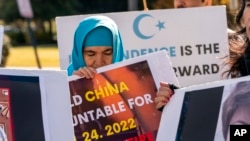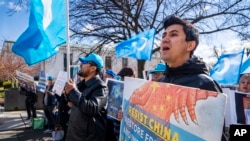Heyrinsahan Abdurahman is a 48-year-old Uyghur mother of seven children. As a single mother for the past five years, she lived with her four of her children at her flat on the 19th floor of a high-rise apartment building in the downtown Tianshan District in Urumqi, the capital city of Xinjiang in northwest China.
When a fire broke out on the 15th floor on November 24, Abdurahman and her children, 13-year-old Shahide, 11-year-old Imran, 9-year-old Abdurahman and 5-year-old Nahdiye, were not able to escape and died, according to Abdulhafiz Muhammadimin, a 27-year-old Uyghur and nephew of Abdurahman.
“My aunt’s husband, Muhammad Ali Metniyaz, and their eldest son, Eliyas, 28, were taken to an internment camp in 2017 by the Chinese authorities,” Muhammadimin told VOA from his residence in Zurich, Switzerland. “Since then, my aunt has become the mother and father of her children.”
Abdurahman’s other two children, who are now 25 and 22, moved to Istanbul for school in 2016 when the government allowed Uyghurs to travel abroad, according to Muhammadimin.
“I and my cousins have lost contact with everyone, including my aunt, since 2017, when the Chinese government began confiscating passports of Uyghurs and arbitrarily arrested my aunt’s husband and their son,” Muhammadimin said.
The fire
On the evening of the fire, according to Muhammadimin, when he saw some video clips of a building on fire in Urumqi, he got in touch through social media with a friend who lived near the building where his aunt lived.
“He said that, at first, the building was on fire, then three children [of my aunt] were in the hospital, but my aunt and her one child was missing,” Muhammadimin told VOA. “Two hours later, he [my friend] said, ‘May God give you patience. Your aunt and her four children died in the house they were living in, because of this fire.’"
The fire, which started around 7:49 p.m. Beijing time, was extinguished by firefighters around 10:35 p.m., according to Chinese state media Xinhua News agency.
“Ten people died after rescue failed,” the Chinese state media said. “Nine people had moderate inhalational lung injury, their vital signs were stable, and they were not life-threatening.”
According to Muhammadimin, the building was close to a fire station and a large regional hospital.
“There is a police station 100 meters from the house. There is a fire station within a kilometer. There is a large hospital less than 2 kilometers away,” he said. “Due to their failed zero-COVID policy and deliberate failure to save lives, my aunt and her four children died.”
'It was impossible for them to get out'
According to Muhammadimin, the Chinese government locked the doors leading to the fire escape stairs when the COVID-19 lockdown began in the region in early August.
“My friend told me that [the government] installed chain locks from outside to the fire escape doors leading to the outside,” Muhammadimin told VOA. “So it was impossible for them to get out and down.”
On November 25, Li Wensheng, a city fire department official in Urumqi, said at a press conference that the residents who died were not familiar with the emergency exit.
“Some residents have weak self-defense and self-rescue capabilities and are not familiar with the location of the second safety exit leading to the roof of the residential building,” Li told the press. “When the fire broke out, effective firefighting and timely escape and self-rescue were not carried out.”
However, according to a family member of a resident in the building, after the fire broke out, a neighborhood committee official used a WeChat group for community residents to instruct everyone to “stay at home” and “not use the elevator.” The family member, a Uyghur living in Urumqi, spoke to VOA on the condition of anonymity for fear of reprisal from the Chinese government.
“When my relatives first went up to the fire exit leading to the roof on the top floor, the fire exit door on the top floor was locked,” the family member told VOA. “Then they came down using the elevator to the first floor. Unfortunately, that exit was also locked by the government officials because of the mask.”
People in Xinjiang use the word mask to refer to the Chinese government’s zero-COVID policy.
“They were allowed to an apartment by a neighbor on the first floor and climbed the windows and successfully escaped the building,” she said. “They were among the few lucky ones. We lost many of our neighbors to this fire.”
Reports of more fatalities
Tahir Imin, founder of Washington-based Uyghur Times news organization, rejected Chinese government claims that only 10 people died in the blaze. He said “at least” a few dozen Uyghurs were killed.
“According to the hospital employees near the building where the casualties were taken, people who died in the fire are not 10 but 44 Uyghurs,” Imin told VOA. “Our news site has confirmed 20 victims’ names and pictures so far. We are working to find out all the victims’ details.”
After many video clips of the failed fire rescue were shared on Chinese social media, such as douyin, the Chinese domestic version of TikTok, many Urumqi residents took to the streets in protest against the zero-COVID policy that has forced them to stay at home for more than 100 days in Xinjiang.
On November 26, according to residents of Urumqi, the government loosened the COVID-19 restrictions and allowed them to go out in their own districts.
The protests, which began in Urumqi after the failed fire rescue, spread to other cities in China, such as Shanghai and Beijing.

